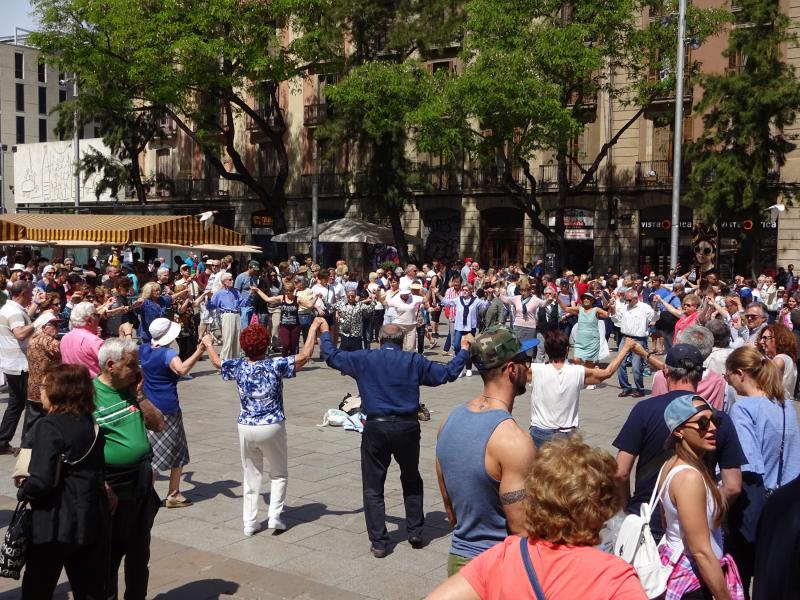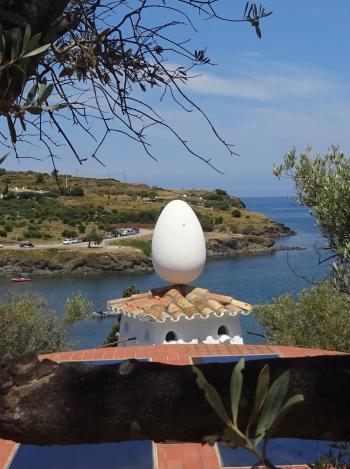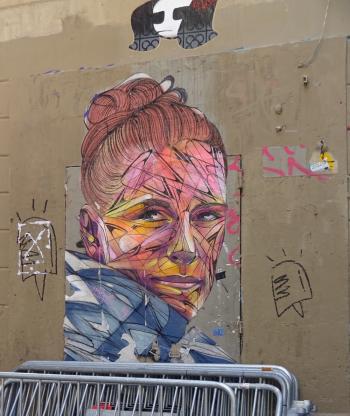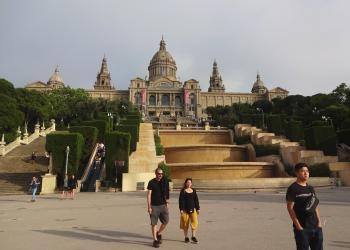An inspired art pilgrimage to Spain’s Catalonia region
This article appears on page 16 of the December 2017 issue.
Due to increased tensions following the region’s declaration of independence and Madrid’s subsequent move to take control of Catalonia’s administration (see p. 2), travelers to this region are, as of press time, being advised to “exercise caution” because of the possibility of continued protests by large crowds.
After visiting the Dalí Museum in St. Petersburg, Florida, I was intrigued by the variety in the artist’s work and the mediums he worked with, and I wanted to pay a visit to the Dalí Theatre Museum in his birth town of Figueres, a 1½-hour train ride north from Barcelona in the Spanish region of Catalonia. Also in this region, a short drive from Figueres, is the lovely coastal town of Cadaqués, where Dalí and his wife, Gala, had a home in nearby Portlligat.
So in May 2017, two friends and I made an art pilgrimage to Catalonia (Catalunya in the Catalan language).
Beginning in Barcelona
Our group started in Barcelona, a city I fell in love with on my first visit five years before. That visit featured all things Gaudí, and priority visits for anyone discovering Barcelona are Casa Milà (aka La Pedrera), an iconic Gaudí-designed apartment building, and the exquisite basilica of La Sagrada Família, a building on which construction began in 1882, with completion now anticipated in 2026. (If you can, time your visit to the basilica for several hours before sunset, when the sun’s movement can create striking, momentary shifts in the light through the stained-glass windows.)
Both sites have timed entries, and it’s best to make your reservations at least a few days ahead, especially if your time in Barcelona is limited.
One of Gaudí’s other creations, Park Güell, is a favorite of many visitors, but I found it very crowded in 2012 and decided it didn’t warrant another visit unless I could skip the crowds.
As with many things in Barcelona, it’s best to time visits to popular sites to avoid the thousands of travelers who pour off the cruise ships daily. There are as many as six cruise ships in port on any given day, although there are days when only one ship is in port. The tourist information offices often know when cruise ships are scheduled to stop.
This time I had priorities other than Gaudí. I wanted to see the famous Catalan castellers, who work together to build human towers as tall as eight people high and who dance the sardana in front of the Cathedral of Barcelona in Ciutat Vella, the Old City. The castellers form associations and hold regular, friendly competitions to see who can build the tallest human tower.
The top of the tower is usually a child of 8 to 10 years old, who must be at the top with one hand raised in the air for the tower to be called complete.
The base of the tower is built very carefully, while the upper tiers are done very quickly, as the people in the middle start to quiver. Towers do collapse.
The event we saw had smaller crews of castellers, with two ambulances standing by — thankfully, not put to use while we were there.
The website www.castellersde barcelona.cat posts a schedule of casteller events, but it’s only partially translated into English. To see the schedule, use the pull-down menu for “Actualitat” and select “Calendari.”
The sardana is a traditional Catalan dance. After the Spanish Civil War, during Franco’s time, it was banned for being a symbol of Catalan nationalism, a sentiment that runs strong among Catalans today.
It’s a simple dance, done while holding hands in a circle and taking a series of slow steps to the right and left followed by many series of faster steps, all in a 1-2-3-4 pattern, almost like a group circle waltz. I stood and watched one of the older dancers, who kept her steps pretty simple, and caught on well enough to join a circle. (Some dancers added all sorts of skips and hops that were confusing.) Tip — do not join a circle if it appears to be for couples.
Museum visits
My friends and I bought Barcelona museum passes online through Viator.com that could be picked up by presenting our receipts to any one of a number of tourist offices in Barcelona. We picked ours up at the airport; there’s a tourist office located in each terminal.
You can also buy the passes in person at the tourist offices or museums, but it was very convenient to show the receipts and quickly receive our documents.
Our passes cost less than $36 each and could be used for up to a year after activation, allowing discounted (45% off) one-time entries at six museums and the opportunity to pass up the entry lines.
We had intended to visit only one or two museums but visited four, so our investment was well worth it.
Of the museums visited — the Museum of Contemporary Art (MACBA), the Picasso, the National Museum of Catalan Art and the Fundació Joan Miró — only at the Picasso Museum did we save much time by skipping the line, which was formidable. (It can take more than an hour of waiting in line for entry.) For those without a pass, you can buy a timed-entry ticket for the Picasso Museum from their website (www.museupicasso.bcn.cat).
I’ve seen a lot of Picasso’s works in person in museums around the world, but I found the Picasso Museum in Barcelona unique. His most famous works are not displayed there. Instead, the museum tries to show the development of his perspective and his process of getting to the final product.
Most fascinating were the rooms devoted to the painting “Las Meninas,” a Picasso tribute to Velázquez’ famous painting of the same name that is exhibited in the Prado in Madrid. Picasso kept many of the paintings that were studies for the final painting, so there were a half dozen depictions of the little girl in the painting on display, but none of them matched the way Picasso finally painted her. It made me want a knowledgeable guide who could shed light on why he rejected different options.
Instead, I was left to decide why I preferred some depictions over others and whether, from my viewpoint, the one Picasso used was the best choice.
I would definitely return to this museum.
Montserrat
We also visited the Museum of Montserrat, a museum I was expecting to pass up. Montserrat is a mountaintop Benedictine monastery dating from the 9th century and located one hour east of Barcelona by train.
The monastery enshrines the Virgin of Montserrat, one of the Black Madonnas of Europe, which draws pilgrims to the site, and during much of the year, daily recitals by Montserrat’s world-famous boys’ choir are performed. There are also wonderful walking paths through the surrounding mountains.
I’d recommend taking the time to visit the art museum there (admission, €7), which houses an outstanding collection of paintings by 19th- to 20th-century Spanish artists, many of whom I had never heard of before. There’s also earlier, religious art, but my eyes didn’t perk up until I viewed the works of Joaquin Mir Trinxet, Francesc Gimeno and Marià Pidelaserra, among others.
Montserrat is easily reached by train from Barcelona, and very specific information on getting there is available at www.cremallerade montserrat.cat. Train tickets are purchased from a vending machine at the station, and you can purchase a number of round-trip tickets at one time.
Our credit cards wouldn’t work with the machine, so we pulled out cash and quickly had our tickets in hand.
Unless you are deathly afraid of heights, I recommend taking the gondola for the final leg of the trip up to the monastery.
There are a number of dining options at Montserrat; we chose the restaurant, where we were served a good meal in comfortable surroundings with a drop-dead gorgeous view into the valley below for not much more than the cost of a meal in the lackluster on-site cafeteria.
Montjuïc
Our visit to Montserrat drove my desire to see more works by 19th- and 20th-century Spanish artists, and I got that opportunity when we spent the day on Montjuïc, the large hill situated on the southern edge of Barcelona.
Montjuïc contains both the Fundació Joan Miró and the National Museum of Catalan Art (MNAC). I found the Miró museum interesting, since he was not an artist I had ever appreciated in the past. Many of the pieces were on loan from his family, and they represented the breadth of his work, including his early and late phases, not just the iconic works most curators obtain for their museums.
MNAC had a collection of 19th- to 20th-century Catalan art that surpassed the Montserrat collection. This was only a small part of what MNAC offered, but it took us several hours to walk through and admire additional works by the same artists who had attracted my attention at Montserrat.
Our bonus prize after a long day on Montjuïc and a refreshing tapas dinner at Tapa Tapa, located in Plaça Espanya at the bottom of the hill, was the magnificent water-and-light Magic Fountain show at the foot of the MNAC stairs.
The show, which starts at sunset and goes on for quite a while, is free to the public and happens on Thursday, Friday and Saturday evenings, with additional evenings added in the summer season. Schedule information is available at tourist offices and at www.barcelona-tourist-guide.com.
We found that the best place to view the Magic Fountain (think Bellagio in Las Vegas but without the music) was from the pedestrian overpasses on Avinguda de Rius i Taulet. It was also a great spot for people-watching.
Getting closer to the fountain guarantees a good soaking as the wind changes directions.
Art in Barcelona is not confined to its museums. There’s lots of street art, from graffiti to state- and business-sponsored murals. The graffiti is especially good near MACBA, which is a student area that includes several art schools.
We were especially taken by the “can art,” painted soda cans affixed to exterior walls, often at corners, with messages like “Spreading Art” and “I have never had a heart so red” in Spanish or English. The works are anonymous, possibly done by several artists, and can be found all over the El Raval neighborhood.
On to Figueres
Getting to Figueres to visit the Dalí Theatre-Museum was very easy by train. There are both fast and slow trains that leave from Barcelona’s Sants and Universitat stations. The slower (and less expensive) train arrives in the center of town, a short walk away from the museum and many hotels, while the fast train arrives on the outskirts of town and requires a taxi ride into the center. The time difference in travel is about 30 minutes, but the advantage of the shorter rail journey is lost in the time it takes to get into the center of the city.
We stayed at Hotel Duran (C/Lasauca, 5), a 6-block walk away from the station and two blocks from the museum. I chose this hotel because its restaurant was one of Dalí’s favorites, and it was very reasonably priced ($70 per night). I was happy to find that, even though it was an older hotel, it had been renovated well and was quite modern and comfortable.
The restaurant exceeded my expectations. There was a tasting menu that we never had enough appetite to undertake, but they had a 3-course menú del día priced at €20 ($23) that was an absolute bargain. If you like sweetbreads and you see mollejas de ternera on the menu, go for it!
The food was so good, we returned there for dinner the next night and ordered from their regular menu. We were not disappointed. Our lovely waiter was very helpful, and when I jokingly complained that everyone spoke English so I couldn’t practice my Spanish, he made a special effort to coax me along in Spanish.
There was a great sidrería (cider bar), Txot’s, up the street from the hotel that was also very good, and we went back there for lunch on our second day in town. If you order a bottle of cider, they set up a cider dispenser at your table so you can add your own effervescence. They also have a full bar that makes excellent gin and tonics plus a good menú del diá as well as pintxos (small snacks) at lunchtime.
But the Dalí Theatre-Museum is the reason why travelers find their way to Figueres. Native son Dalí began working with the local government in the 1960s to renovate an abandoned theater into a museum featuring his art.
The museum has pieces from throughout his career. His early works are quite traditional artistic representations, while his later conceptual pieces made me both laugh and scratch my head trying to figure out what he was thinking. With the Dalí Museum, he guaranteed that his hometown would continue to profit from his fame.
Many people make a day trip to Figueres from Barcelona, but I thoroughly enjoyed our leisurely 36 hours there. We arrived the night before our scheduled museum visit and departed for Cadaqués the day after.
Military buffs and scenic-view junkies will appreciate Sant Ferran Castle, a 30-minute uphill walk from the Dalí Museum. This large, very stark fortress was converted to museum status in 1997 and offers panoramic views of the surrounding countryside. It’s also where the young Dalí fulfilled his military service.
Cadaqués
The final leg of our Catalan art pilgrimage was Cadaqués and the neighboring village of Portlligat. Cadaqués is a lovely coastal town, and we stayed at the kitschy Hotel La Residència (Avgda. Caritat Serinyana, 1), where my airy room facing the bay, less than a block away across an open plaza, cost $96 per night.
Bus service from Figueres to Cadaqués is very limited. At the time of our visit, there were only two buses a day, with inconvenient departure and arrival times, so we opted for a cab, which cost €70 for the half-hour trip. (The bus would have cost €7 each.)
Portlligat, where Dalí lived from 1930 to 1982, is a good 30-minute walk north of Cadaqués — both uphill and downhill, so there’s no “easy” direction.
It was nice to come upon Dalí’s house as kind of a surprise. We first saw a beautiful bay with boats docked, then noticed a chimney with a camel’s head sticking out of it and two giant silver human heads below.
Admission to Dalí’s house must be prebooked (€11, adult, or €8, senior). Small-group tours (10 people) are allowed entry every 15 minutes. They often sell out days in advance, so book early.
The tour group ahead of us appeared to be mostly French-speaking visitors, while the people in our group were English-speaking, with one French-speaking couple. Our guide through the house was able to accommodate both languages.
Walking through Dalí’s house was a bit like walking through Dalí’s mind. He loved to surround himself with odd items so they would spark his imagination and lead to strange connections. I learned about his fixation with items like eggs, which he used to connote creativity, birth and rebirth.
While he could be a grandmaster of theater and kitsch, he could also delve deeply into the psychological theories of Sigmund Freud and Carl Jung.
Cadaqués is a vacation town in summer, so, while we were able to get walk-in seating at a good restaurant on Thursday night, we had to visit several recommended restaurants on Friday night before we found one that was not fully booked.
I thoroughly enjoyed my art pilgrimage — half planned, half serendipitous — and recommend it to anyone who would like to explore the richness and variety of art in Catalonia.




